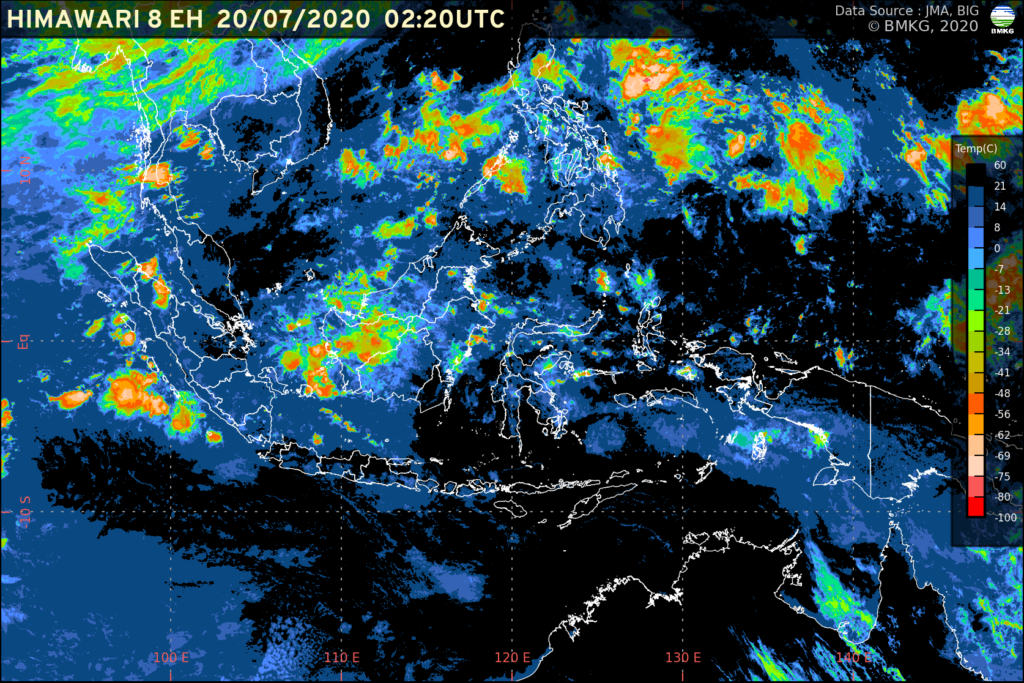BMKG Warns Heavy Downpours in Some Regions

Satellite imagery of weather conditions, Monday (20/7). (Source: the Meteorology, Climatology and Geophysics Agency)
Some regions in Indonesia will suffer from drought, while heavy downpours are expected to hit several other regions, the Meteorology, Climatology, and Geophysics Agency (BMKG) Head Dwikorita Karnawati has said.
“For example, when the dry season hits almost in most parts of southern Indonesia, the central part of Indonesia from Central Sulawesi, Maluku to northern Papua had the potential to get relatively high rainfall in the next two dasarian (20 days),” the Head of BMKG said.
Meanwhile, based on BMKG monitoring results, the dry season will continue until October. BMKG Climatology Deputy Herizal explained, that of the 342 Season Zone (ZOM) areas in Indonesia, as many as 64% of ZOM had entered the dry season until mid-July. This is in line with the dominance of the Australian Monsoon wind circulation which is dry and blows from the east-southeast.
The areas that have entered the dry season include: East Nusa Tenggara, West Nusa Tenggara, Bali, East Java, most parts of Central Java and West Java, West and East Jakarta, north coast of Banten, east coast of Jambi, Riau and Aceh, central, northern and eastern parts of North Sumatra, western part of South Kalimantan, eastern part of Central Kalimantan , southern part of South Sulawesi , west coast of South Sulawesi, southern part of Southeast Sulawesi , western part of Maluku, eastern part of West Papua, and central, southern and northern parts of Papua.
Of the areas that have entered the dry season, 30% of ZOM has experienced dry conditions based on the indicator of consecutive days without rain (HTH) or series of dry days varying from 21 to 30 days, 31 to 60 days, and above 61 days.
“The longest HTH occurred in Oepoi of Kupang City, East Nusa Tenggara for 70 days. Meanwhile, BMKG has predicted that for the next 9 (nine) months, the dry season will generally last until October 2020,” Herizal added.
However, regions that have not experienced drought also need to be aware of the potential for rainfall with criteria of High to Very High in the next 4 (four) months, Herizal warned.
These areas include parts of Aceh, West Sumatra, West Kalimantan, North Kalimantan, Southeast Sulawesi, Central Sulawesi, West Sulawesi, North Maluku, West Papua and parts of Papua (in July 2020); parts of Aceh, West Sumatra, West Kalimantan, North Kalimantan, West Sulawesi, North Maluku, West Papua, and parts of Papua (in August 2020); Aceh, parts of North Sumatra, West Sumatra, West Kalimantan and North Kalimantan, West Sulawesi, West Papua and parts of Papua (September 2020); Aceh, North Sumatra, West Sumatra, Bengkulu, West Kalimantan, North Kalimantan, West Sulawesi, West Papua and most parts of Papua (October 2020).
The potential is based on the condition of the seawater surface temperature of Indonesian waters which is still quite warm, thus supplying enough moisture to the atmosphere due to evaporation. Meanwhile, tropical equatorial wave activity (Kelvin and Rossby waves) and the mass flow of Pacific Ocean air entering Indonesia have the potential to cause increased activity in the formation of convective clouds in the north of the equator of Indonesia, especially in eastern and central parts of Indonesia.
According to Head of the Center for Applied Climate Information Services Nasrullah, based on BMKG probabilistic rainfall forecasts, some areas such as parts of Central Sulawesi and Papua have the potential to be flooded with a ‘high’ category in dasarian II, this July.
This forecast has been overlaid on a map of flood-prone areas made by the Geospatial Information Agency (BIG) and the Ministry of Public Works and Public Housing (PUPR).
“Meanwhile, in dasarian III or in the last 10 days in July, the following areas: parts of Aceh, North Sumatra, West Sumatra, Jambi, West Kalimantan, East Kalimantan, North Sulawesi, Gorontalo, Central Sulawesi, West Sulawesi, Maluku, North Maluku, West Papua, and Papua, are at ‘medium’ risk of being flooded.
While on the Dasarian I or the first ten days in August, flood is also predicted to hit some parts of West Papua,” Nasrullah said.
To monitor weather conditions following week, Head of the Center for Public Meteorology Fachri Radjab revealed that a number of areas such as the west coast of Sumatra, West and North Kalimantan, West, Central, and South Sulawesi, as well as central Papua need to be aware of the potential of heavy rains and their impacts.
“Meanwhile, the East Nusa Tenggara region is predicted to still experience dry conditions,” Fachri said.
As an effort to prevent/reduce the risk of hydrometeorological disasters, Dwikorita emphasized that the 5 Main BMKG Centers in the West, Central and East Indonesia Regions and BMKG Coordinator Stations throughout Extreme Weather and Hydrometeorological Disaster Prone Provinces continued to intensify the dissemination of Early Warning to the community to raise massive awareness and support efforts to prevent such disasters. One of them is by increasing synergy with the BPBD (Regional Disaster Mitigation Agency), PUPR, and the local radio network. (BMKG PR/EN)
Translated by: Fairuzzamani Inayatillah
Reviewed by: Mia M. Bonaedy








